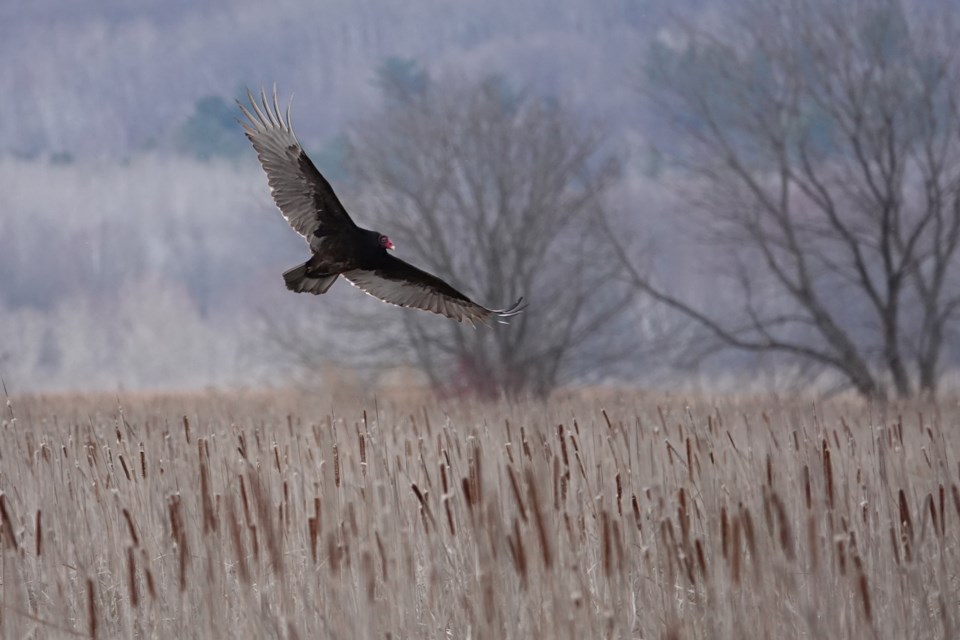Of all the signs of spring you may look forward to, I’m guessing that way down the list is the first spring sighting of a turkey vulture. Robins, pussy willows, and crocus flowers are usually way up there ... but turkey vultures?
Every spring time, when there is that first sighting of a vulture drifting in the air currents, you feel a tad guilty of not really anticipating their return (or at least I do). “Sorry about that, somehow I overlooked your name on the guest list ... but glad you came to the party!”
These birds are big, way bigger than most in our region, and they like to hang out in the open areas, so it’s pretty easy to see one if there’s one to be seen. They usually hang out in rural areas, often hunting the fields adjacent to roads. This location is not by accident or happenstance, as these scavengers are seeking the thawing remains of animals clipped by cars which then crawled into the field to die.
Being scavengers, as opposed to glorious hunters, they are oft overlooked by the glory seeking birdwatchers. Which is odd as bald eagles are also scavengers (although they can catch their own fish if the situation calls for it). Bald eagles are considered way cool, vultures not so much.
No doubt part of the vultures' less than 10/10 rating is that they are quite ugly, at least in the head department. No feathers, just red and grey skin. Yuck!
I once read that vultures evolved to be without head feathers as they have to reach deep inside the body cavity of a rotting carcass to get the yummy bits, and if they had feathers they wound get coated in slime and goo and cause inflammation and infection. No feathers? No problem ... just give your skin-covered head a swish in the grasses and you’re good to go!
However, the trouble with that theory is that wild turkeys are also bare headed. And they don’t usually rip into a deer carcass. So maybe we’ll just leave that thought-provoking concept behind and move onto other things.
The wing span of a turkey vulture is impressively large, and they have the ability to glide for great amounts of time without once flapping their wings. Indeed, it’s the sight of them wheeling overhead in lazy circles that provides their characteristic profile.
This low energy requirement type of flight is good, as these birds can’t always find a ready food supply to replenish the energy lost to all that flapping and flying that the other birds do. Hawks and falcons are always on the active hunt, as they expend a whole pile of energy while seeking new sources of energy; turkey vultures are too laid back for all that high-stress hunting and killing.
I do wonder how the early spring vultures survive, as juicy succulently warm solar-cooked meat on the pavement is difficult to come by in early April. Apparently vultures have the ability to lower their body temperatures at night to conserve what remaining muscle energy they do have; so the early bird that misses the worm at least can survive the night.
For a while, in my earlier birdwatching days, I wondered why eagles got all the leading roles in traditional legends but the turkey vulture fails to get even a mention. When the history of this bird is examined, the answer is obvious ... they simply didn’t exist around the Great Lakes in the days of the first human’s arrival to this area.
Way back then, turkey vultures were found from what we now call the American mid-west all the way down to Argentina. As settlement by Europeans occurred, the landscape changed and roads were built; cattle that sometimes died and were left in a corner of the field to rot, and this attracted the vultures slowly but steadily northwards.
Southern Ontario was vulture-free until the mid-1880s, and then it was only the rare sighting of one. Simcoe County didn’t have much of a vulture presence until the 1950s. But they have continued to arrive, and thrive, throughout our agricultural landscape.
Vultures lay two eggs a year, on the ground (let those arrogant eagles have the tree nests ... who cares?) I have found nests inside abandoned barns, between rows of stacked cordwood and inside rocky crevices.
Being on the ground, they are susceptible to attacks from raccoons, skunks, dogs and overzealous nature photographers. The adults do not aggressively defend the nest, instead flying a short distance away to hope and pray the nest goes undiscovered.
The nestlings do, however, have a unique way of defending themselves. Mom and Dad Vulture bring them well-rotted bits of meat picked off warm roadways (best to let it lay for a couple days to really soften it up), that is regurgitated from the crop of the adult to the young bird. When stranger danger comes to the nest, the young ones re-regurgitate the smelly mess with force!
An interesting note gleaned from recent breeding atlases, shows that turkey vultures are becoming quite common in the areas up to the Canadian Shield. It is thought that as the southern parts of its range have become 100 per cent human occupied, the birds are moving northwards to boldly go where no turkey vultures have gone before, to discover new areas to make nests and survive.
In addition to the range extensions, we are providing the birds with a ready supply of squished meat as we build more and more roads. Interesting inter-species relationship or what?
